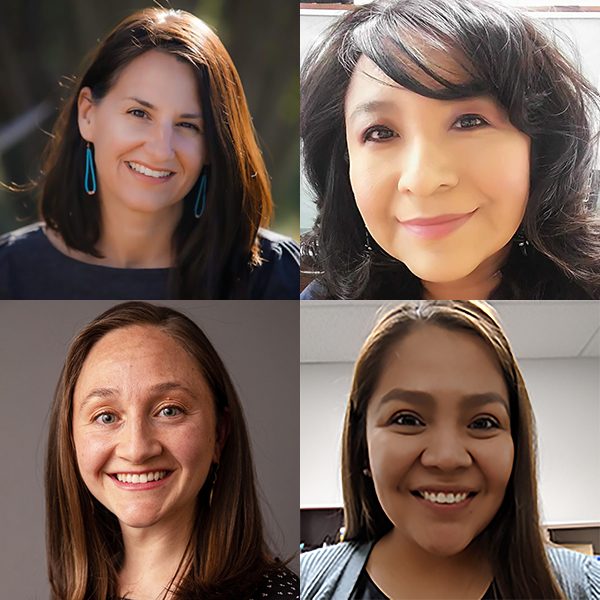 About 40 community health workers and university faculty members from around the state attended a recent Community Health Workforce Assessment Webinar online on June 24.
About 40 community health workers and university faculty members from around the state attended a recent Community Health Workforce Assessment Webinar online on June 24.
The event was sponsored by the Arizona Advisory Council on Indian Health Care (AACIHC), the Northern Arizona University Center for Health Equity Research and the Arizona Community Health Representative (CHR) Workforce Coalition.
Speakers included Kim Russell, executive director of the AACIHC, Samantha Sabo, associate professor in the NAU Department of Health Sciences and CHER, Louisa O’Meara, research assistant for CHER and moderator Cory Hemstreet, health program manager for AACIHC.
In her presentation, Russell, called CHRs a “unique and distinct workforce.”
“First of all, we know that CHRs have a relationship (with their clients) and trust building to identify the specific needs of their clients,” Russell said.
Russell showed a picture of a blue T-shirt emblazoned with, “Community Health Representative: We Solve Problems You Did Know You Had in Ways You Don’t Understand.”
“This I think it really speaks to the unique nature of the CHR workforce and how valuable you are,” she said of the motto.
Russell said she really believes in the work of CHRs and the impact they make in their communities. She said that CHRs specifically focus on social determinants of health, which she said are conditions in which people are born, grow, work, live, and age. Social determinants of health include areas such as access to health care and quality housing, as well as social connectedness, traditional knowledge and spirituality, and relationship to the environment.
“They have to have particularly strong communication skills with the clients they interact with as well as with the providers they interact with,” she said of CHRs.
Russell said that CHRs are able to provide both continuity and clarity between the provider and the patient with traditional knowledge and language. “Continuity of care” for CHRs means coordinating care for their clients that involves all aspects of health, from physical and behavioral health to social services, nutrition, housing, and transportation.
Community Health Representative Workforce Assessment review
Sabo reviewed the Phase I Community Health Representative Workforce Assessment, commissioned by the Arizona Advisory Council on Indian Health Care, which was published last year and Phase II of the assessment, which they are now working on that builds on their Phase I findings.
Sabo said the 28-page Phase I report helped them learn more about the CHRs and involved collecting CHR job descriptions, developing a CHR workforce database, comparing CHR competencies and identifying CHR program outcomes and impact evaluation.
Sabo said the more they learn about the CHR workforce, the more they can discover how to better work for them to support the professional development, career advancement and financing of the CHR profession and workforce in Arizona.
According to Sabo, there are approximately 55,000 community health workers (CHW) employed in the United States in every state and in almost every territory. Nationally, the CHR workforce, who are tribally employed CHWs, consists of approximately 1,700 CHRs representing 264 tribes.
Of the 22 tribes in Arizona, 19 tribes operate a CHR program and employ 246 CHRs, which is equivalent to approximately 30 percent of the total CHW workforce in Arizona––estimated at about 1,000 CHWs.
The researchers’ evidence gathering included four areas of study––scientific evidence, workforce, evaluation and impact, and tribal health systems––that answer the questions:
O’Meara said that in Phase II, the researchers engaged seven program managers at six CHR programs, conducting in-depth qualitative interviews with them about program infrastructure, financing, evaluation, and innovative ways CHRs are addressing COVID-19. She said they represented a range of CHR programs, varying in size, geographic location, and funding strategies.
CHR COVID-19 response
O’Meara said that in many of the tribes, CHRs have played an integral part in the response to COVID-19. Some have provided COVID-19 kits that include gloves, sanitizer, and other safety supplies, while others are helping to distribute much needed food, water, and firewood. Some programs are also assisting with testing and contact tracing, transportation to and from testing sites and case management of COVID-19 positive patients.
Sabo said that they will continue to work on data collection, conducting the remaining interviews and creating the final report for dissemination by the fall.
“We really value the way the Advisory Council and NAU have worked with the CHR Coalition, so we share the drafted report back to our partners for interpretation and meaning making–– to make sure we are getting it right, that we are interpreting it right, and that we can make better recommendations as a group,” Sabo said.
For more information on the community health workers or to watch the full webinar video, go to the CHER Community Health Workers page.